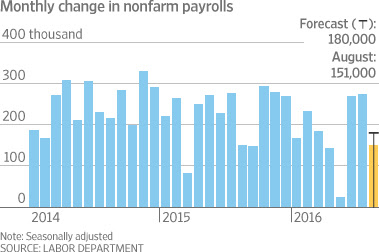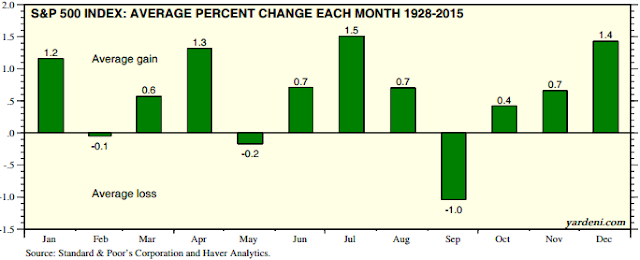Stocks turned in decent gains on the week. Through Friday’s close, the Dow added 0.8%, the S&P rose 1.2%, and the Nasdaq was higher by 1.2%. Bonds prices also rose as their yields fell. Gold turned in a solid week with a 2.1% rise. Oil rose, too, up 3.2% to close at $44.59 per barrel. The international Brent oil added just two cents to close at $46.07.
Source: Google Finance
All eyes were on the central banks this week. The U.S. and Japanese central banks held policy meetings and investors were anxious for any policy changes.
Both Monday and Tuesday saw the markets open with large gains as optimistic investors bought stocks in anticipation that further stimulus would boost stock prices. However, those early gains faded as investors thought there may be a chance the Fed will pull back on their stimulus by raising interest rates. This back-and-forth showed how undecided investors were about Fed policy – and how important it is for the market.
In the end, the Fed left rates unchanged. As you can see in the chart above on Wednesday, the market liked the news.
Fed chief Yellen did make note that conditions are improving and a rate hike at their meeting in December was on the table. These comments were interesting since the Fed’s official forecast actually lowered its expectations for economic growth. They now see the economy growing just above stall-speed in the years ahead, which is even more worrisome since they have always – always – been too high in their economic projections. At least they are constant in that regard.
The Bank of Japan (BOJ) was the other central bank investors were keeping an eye on. They are important because they have already thrown in the kitchen sink when it comes to stimulus. They’re printing tons of money to buy stocks and bonds and have lowered interest rates to negative territory. None of this has failed to produce any economic growth, so investors wondered what else they could throw at it – if anything.
They announced no new changes to interest rates or money-printing programs outside of printing a bit more money to buy more stocks. They also will target a specific interest rate of zero on their ten-year bond, which may see them printing more money to accomplish.
At this point they are throwing everything at the wall and hoping something will stick. Their actions are very important to follow since we are following their exact path.
Finally, there was an interesting development from Facebook this week that could spell trouble for many of these tech firms. The company significantly overstated (lied) about how long users spent watching ads. Most of these large tech companies rely on advertising dollars, so companies may reduce their advertising spending if they find them to be ineffective. This will impact the bottom line of these tech companies – which we feel are already grossly overvalued.
Next Week
Next week looks to be a pretty busy one. The Fed will still be in the news, with Fed chief Yellen appearing before Congress and many regional presidents making speeches.
There will also be several economic reports out, including data on housing, durable goods, and a revision to second quarter GDP.
Finally, an OPEC meeting this week could add some volatility to the oil markets. Our stock market has been pretty closely correlated to the oil market recently, so it may add to stock market volatility.
Investment Strategy
We have rallied off the lows of the past two weeks and no longer see a good buying opportunity for the short term. Of course, comments from central bankers have the potential to swing markets strongly one way or another, so it is difficult to make any credible predictions.
Our longer view remains unchanged as we continue to have serious concerns. These massive stimulus programs have masked many problems, causing a misallocation of resources and allowed bubbles to form. It prevented necessary changes from occurring at both a corporate and political level – changes that would actually help the economy. Just how far out this day of reckoning is remains anyone’s guess, however.
Bonds prices rose this week as yields fell, but remain in the range of a rising trend we have seen since July. There are talks of the bubble bursting in the bond market (where prices would fall) and we do agree that bond prices are very high. However, we think prices will remain relatively high and yields low as demand from investors will keep prices elevated.
Bonds to protect against inflation, or TIPs, remain a good long term hedge for inflation. Floating-rate bonds will do well if interest rates eventually do rise.
Some municipal bonds look attractive for the right client, too. We like buying individual, insured names for these bonds, avoiding muni index bonds if possible. We keep a longer term focus with these investments.
Gold is another good hedge for the portfolio. It is only a hedge at this point – rising on geopolitical issues as a flight to safety.
Finally, in international stocks, we see weakness around the globe and favor neither the developed or emerging markets.
Please note, these day-to-day and week-to-week fluctuations have little impact on positions we intend to hold for several years or longer. Our short and medium term investments are the only positions affected by these daily and weekly fluctuations.
This commentary is for informational purposes and is not investment advice, an indicator of future performance, a solicitation, an offer to buy or sell, or a recommendation for any security. It should not be used as a primary basis for making investment decisions. Consider your own financial circumstances and goals carefully before investing. Past performance cannot guarantee results.
Both Monday and Tuesday saw the markets open with large gains as optimistic investors bought stocks in anticipation that further stimulus would boost stock prices. However, those early gains faded as investors thought there may be a chance the Fed will pull back on their stimulus by raising interest rates. This back-and-forth showed how undecided investors were about Fed policy – and how important it is for the market.
In the end, the Fed left rates unchanged. As you can see in the chart above on Wednesday, the market liked the news.
Fed chief Yellen did make note that conditions are improving and a rate hike at their meeting in December was on the table. These comments were interesting since the Fed’s official forecast actually lowered its expectations for economic growth. They now see the economy growing just above stall-speed in the years ahead, which is even more worrisome since they have always – always – been too high in their economic projections. At least they are constant in that regard.
The Bank of Japan (BOJ) was the other central bank investors were keeping an eye on. They are important because they have already thrown in the kitchen sink when it comes to stimulus. They’re printing tons of money to buy stocks and bonds and have lowered interest rates to negative territory. None of this has failed to produce any economic growth, so investors wondered what else they could throw at it – if anything.
They announced no new changes to interest rates or money-printing programs outside of printing a bit more money to buy more stocks. They also will target a specific interest rate of zero on their ten-year bond, which may see them printing more money to accomplish.
At this point they are throwing everything at the wall and hoping something will stick. Their actions are very important to follow since we are following their exact path.
Finally, there was an interesting development from Facebook this week that could spell trouble for many of these tech firms. The company significantly overstated (lied) about how long users spent watching ads. Most of these large tech companies rely on advertising dollars, so companies may reduce their advertising spending if they find them to be ineffective. This will impact the bottom line of these tech companies – which we feel are already grossly overvalued.
Next Week
Next week looks to be a pretty busy one. The Fed will still be in the news, with Fed chief Yellen appearing before Congress and many regional presidents making speeches.
There will also be several economic reports out, including data on housing, durable goods, and a revision to second quarter GDP.
Finally, an OPEC meeting this week could add some volatility to the oil markets. Our stock market has been pretty closely correlated to the oil market recently, so it may add to stock market volatility.
Investment Strategy
We have rallied off the lows of the past two weeks and no longer see a good buying opportunity for the short term. Of course, comments from central bankers have the potential to swing markets strongly one way or another, so it is difficult to make any credible predictions.
Our longer view remains unchanged as we continue to have serious concerns. These massive stimulus programs have masked many problems, causing a misallocation of resources and allowed bubbles to form. It prevented necessary changes from occurring at both a corporate and political level – changes that would actually help the economy. Just how far out this day of reckoning is remains anyone’s guess, however.
Bonds prices rose this week as yields fell, but remain in the range of a rising trend we have seen since July. There are talks of the bubble bursting in the bond market (where prices would fall) and we do agree that bond prices are very high. However, we think prices will remain relatively high and yields low as demand from investors will keep prices elevated.
Bonds to protect against inflation, or TIPs, remain a good long term hedge for inflation. Floating-rate bonds will do well if interest rates eventually do rise.
Some municipal bonds look attractive for the right client, too. We like buying individual, insured names for these bonds, avoiding muni index bonds if possible. We keep a longer term focus with these investments.
Gold is another good hedge for the portfolio. It is only a hedge at this point – rising on geopolitical issues as a flight to safety.
Finally, in international stocks, we see weakness around the globe and favor neither the developed or emerging markets.
Please note, these day-to-day and week-to-week fluctuations have little impact on positions we intend to hold for several years or longer. Our short and medium term investments are the only positions affected by these daily and weekly fluctuations.
This commentary is for informational purposes and is not investment advice, an indicator of future performance, a solicitation, an offer to buy or sell, or a recommendation for any security. It should not be used as a primary basis for making investment decisions. Consider your own financial circumstances and goals carefully before investing. Past performance cannot guarantee results.






